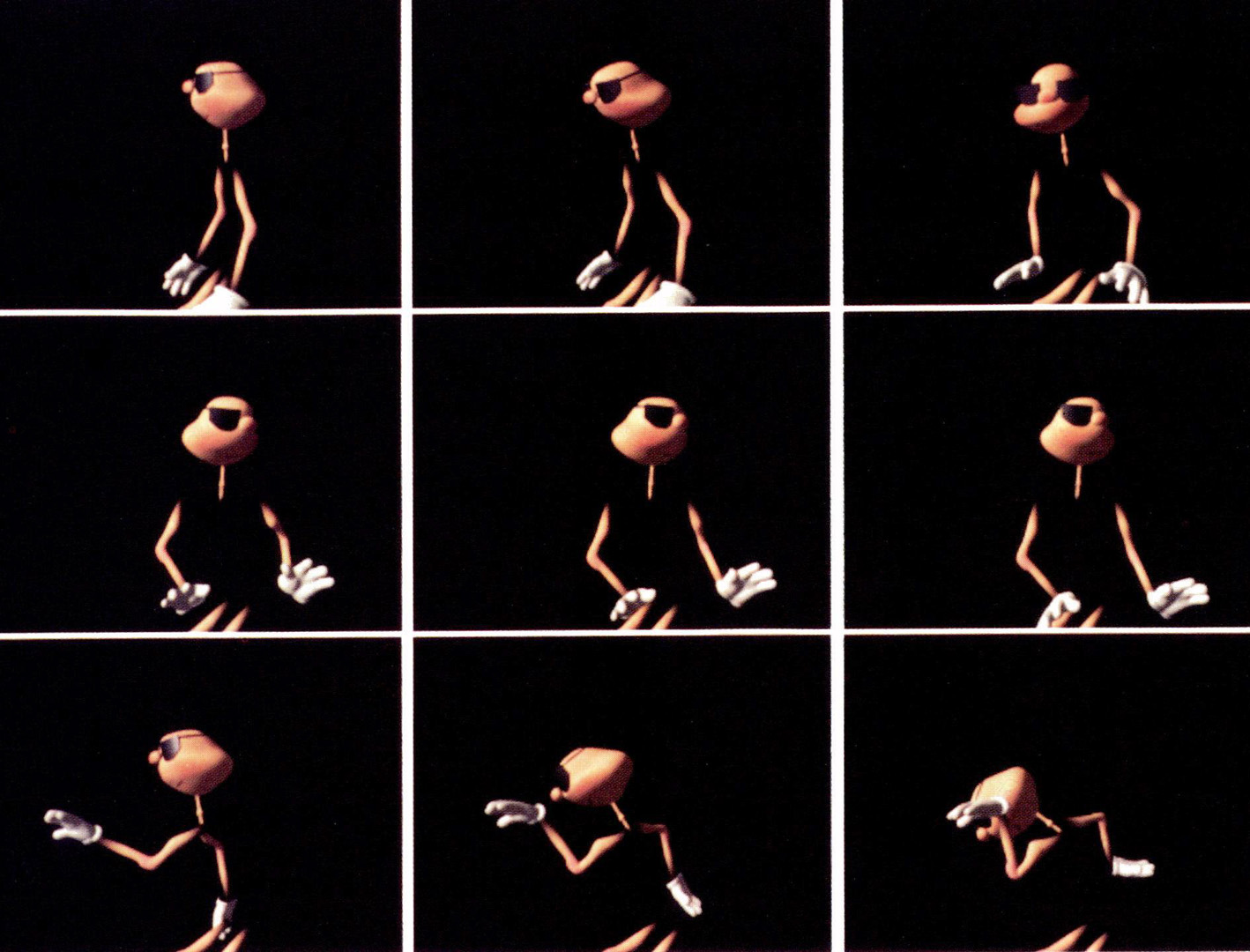“Layered construction for deformable animated characters” by Chadwick, Haumann and Parent
Conference:
Type(s):
Title:
- Layered construction for deformable animated characters
Presenter(s)/Author(s):
Abstract:
A methodology is proposed for creating and animating computer generated characters which combines recent research advances in robotics, physically based modeling and geometric modeling. The control points of geometric modeling deformations are constrained by an underlying articulated robotics skeleton. These deformations are tailored by the animator and act as a muscle layer to provide automatic squash and stretch behavior of the surface geometry. A hierarchy of composite deformations provides the animator with a multi-layered approach to defining both local and global transition of the character’s shape. The muscle deformations determine the resulting geometric surface of the character. This approach provides independent representation of articulation from surface geometry, supports higher level motion control based on various computational models, as well as a consistent, uniform character representation which can be tuned and tweaked by the animator to meet very precise expressive qualities. A prototype system (Critter) currently under development demonstrates research results towards layered construction of deformable animated characters.
References:
1. Thomas & Johnston, “Disney Animation: The Illusion of Life”, Abbeville Press, New York, ’84.
2. Lasseter, John, “Principles of Traditional Animation Applied to 3D Computer Animation”, Computer Graphics, Vol. 21, No. 4, ’87.
3. Gomez, Julian, “Twixt: A 3-D Animation System”, Proceedings of Eurographics 84, ’84.
4. Sturman, David, “Interactive Keyframe Animation of 3-D Articulated Models”, Proc. Graph. Interface, ’84.
5. Van Bearle, “A Case Study of Flexible Figure Animation”, 3- D Character Animation by Computer Course Notes, Siggraph ’87.
6. Forsey & Bartels, “Hierarchical B-Spline Refinement”, Computer Graphics, Vol. 22, No. 4, ’88.
7. Barr, Alan, “Global and Local Deformations of Solid Primifives”, Computer Graphics, Vol. 18, No. 3, July, ’84.
8. Sederberg & Parry, “Free Form Deformations of Solid Geometric Models”, Computer Graphics, Vol. 20, No. 4, ’86.
9. Barr, Alan, “Dynamic Constraints”, State of the Art in Image Synthesis Course Notes, Siggraph, ’86.
10. Terzopoulos, Platt, Barr, and Fleischer, “Elastically Deformable Models”, Computer Graphics, Vol. 21, No. 4, July, ’87.
11. Haumann & Parent, “The Behavioral Testbed: Obtaining Complex Behavior from Simple Rules”, The Visual Computer, Special Issue on Mechanics, Control and Animation, Vol. 4, No. 6, Dec., ’88.
12. Hahn, James, “Realistic Animation of Rigid Bodies”, Computer Graphics, Vol. 22, No. 4, ’88.
13. Moore and Wilhelms, “Collision Detection and Response for Computer Animation”, Computer Graphics, Vol. 22, No. 4, ’88.
14. Terzopoulos and Fleischer, “Modeling inelastic Deformation: Viscoelasticity, Plasticity, Fracture”, Computer Graphics, Vol. 22, No. 4, August’88.
15. Terzopoulos and WitkJn, “Physically Based Models with Rigid and Deformable Components”, IEEE CG&A, November, ’88.
16. Miller, Gavin, “The Motion Dynamics of Snakes and Worms”, Computer Graphics, Vol. 22, No. 4, ’88.
17. Witkin, Fleischer, & Burr, “Energy Constraints on parameterized Models”, Computer Graphics, VoI. 21, No. 4, ’87.
18. Barzel & Burr, “A Modeling System Based on Dynamic Constraints”, Computer Graphics, Vol. 22, No. 4, ’88.
19. Witkin and Kass “Spacetime Constraints”, Computer Graphics, Vol. 22, No. 4, ’88.
20. Platt and Burr, “Constraint Methods for Flexible Objects”, Computer Graphics, Vol. 22, No. 4, ’88.
21. Girard & Maciejewski, “Computational Modeling for Comuter Animation of Legged Figures”; Computer Graphics, Vol. 19, No. 3, ’85.
22. Girard, Michael, “interactive Design of 3-D Computer Animated Legged Animal Motion”, Chapel Hill Interactive Computer Graphics Interface Workshop, ’86.
23. Badler, Manoochehri, Waiters, “Articulated Figure Positioning by Multiple Constraints”, IEEE CG&A, June, ’87
24. Armstrong & Green, “The Dynamics of Articulated Rigid Bodies for purposes of Animation”, Proc. Graphics Interface 85, ’85.
25. Wilhelms, Jane, “Using Dynamic Analysis for Realistic Animation of Articulated Bodies”, IEEE CG&A, June, ’87.
26. Isaacs and Cohen, “Controlling Dynamic Simulation with Kinematic Constraints, Behavioral Functions and Inverse Dynamics”, Computer Graphics, Vol. 21, No. 4, July, ’87.
27. Zeltzer, David, “Representation and Control of Three dimensional Computer Animated Figures”, Ph.D. Dissertation, The Ohio State University, ’84.
28. Amkxaut, Susan, “Flock: A Behavioral Model for Computer Animation”, M.A. Thesis, The Ohio State University, ’89.
29. Reynolds, Craig, “Flocks, herds and Schools; A Distributed Behavioral Model”, Computer Graphics, ’87.
30. Burtnyk & Wein, “Interactive Skeleton Techniques for Enhancing Motion Dynamics in Key Frame Animation”, CACM, Vol. 19., No. 10, Oct. ’76.
31. Parent, Richard, “A System for Generating 3-Dimensional Data for Computer Graphics”, Ph.D. Dissertation, The Ohio State University, ’77.
32. Magnenat-Thalmann & Thalmann, “The Direction of Synthetic Actors in the Film Rendezvous a Montreal”, IEEE CG&A, Dec., ’87.
33. Donkin, John, personal communication ’88.
34. Denavit & Hartenberg, “A Kinematic Notation for Lower- Pair Mechanisms Based on Matrices”, J Appl Mech, Vol. 23, ’55.
35. Whitney, “The Mathematics of Coordinated Control of Prosthetic Arms and Manipulators”, Journal of Dynamic systems, Measurement, and Control, Dec., ’72.
36. Klein, Huang, “Review of Pseudoinverse Control for Use with KinematicaUy Redundant Manipulators”, IEEE Transactions on Systems, Man, and Cybernetics, Vol SMC-132, No. 3, March/April ’83.
37. Chadwick and Parent, “Critter Construction: Developing Characters for Computer Animation’, Proceedings Pixim, “88.
38. Steindler, Arthur, “Kinesiology of the Human Body”, Charles C. Thomas Publisher, Springfield Illinois, ’55.
39. Burstein, A., Frankel, V., “The Viscoelastic Properties of Some Biological Materials”, Materials in Biomedical Engineering Vol. 146, Article 1, p. 158-165, Annals of the New York Academy of Sciences, January 1968.
40. Schneider D., et al.,”In Vitro Biaxial Stress-Strain Response of Human Skin”, Arch Otolaryngol Vol 110, p. 329-333, May 1984
41. Fung, Y. C., Biomechanics: Mechanical Properties of Living Tissues, Springer-Verlag, New York, 1981.
42. Lundin, R. Ruminations of a Model Maker IEEE Computer Graphics and Applications 7 (5):3-5 May 1987
43. Waters, K. A Muscle Model for Animating Three-Dimensional Facial Expression Computer Graphics 21(4):17-24 (Siggraph Proceedings) July 1987
44. Weil, J. The Synthesis of Cloth Objects Computer Graphics 20(4):49-54 (Siggraph Proceedings) August 1986




